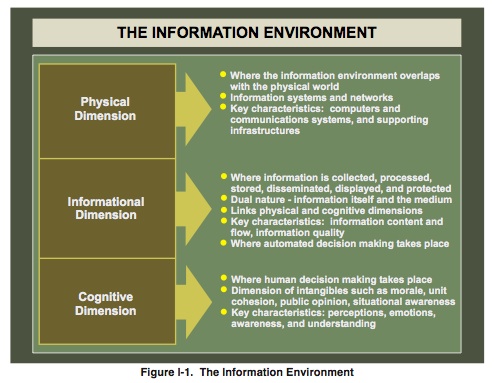No edit summary |
No edit summary |
||
| Line 2: | Line 2: | ||
:::[[File:Snapshot_2009-10-31_18-37-40.jpg]] |
:::[[File:Snapshot_2009-10-31_18-37-40.jpg]] |
||
| + | |||
| + | : '''The Physical Dimension.''' The physical dimension is composed of the [[command |
||
| + | and control]] ([[C2]]) systems, and supporting infrastructures that enable individuals and organizations to conduct operations across the air, land, sea, and space domains. It is also the dimension where physical platforms and the [[communications network]]s that connect them reside. This includes the means of [[transmission]], infrastructure, technologies, groups, and populations. |
||
| + | |||
| + | : '''The Informational Dimension.''' The informational dimension is where [[information]] is [[collect]]ed, [[data processing|processed]], [[store]]d, [[disseminate]]d, [[display]]ed, and protected. |
||
| + | |||
| + | |||
| + | : '''The Cognitive Dimension.''' The cognitive dimension encompasses the mind of |
||
| + | the decision maker and the [[target audience]] ([[TA]]). This is the dimension in which people think, perceive, visualize, and decide. It is the most important of the three dimensions. |
||
== References == |
== References == |
||
Revision as of 01:41, 1 November 2009
The information environment is the aggregate of individuals, organizations, and systems that collect, process, disseminate, or act on information. The actors include leaders, decision makers, individuals, and organizations. Resources include the materials and systems employed to collect, analyze, apply, or disseminate information. The information environment is where humans and automated systems observe, orient, decide, and act upon information, and is therefore the principal environment of decision making. Even though the information environment is considered distinct, it resides within each of the four domains. The information environment is made up of three interrelated dimensions: physical, informational, and cognitive.[1]
- The Physical Dimension. The physical dimension is composed of the [[command
and control]] (C2) systems, and supporting infrastructures that enable individuals and organizations to conduct operations across the air, land, sea, and space domains. It is also the dimension where physical platforms and the communications networks that connect them reside. This includes the means of transmission, infrastructure, technologies, groups, and populations.
- The Informational Dimension. The informational dimension is where information is collected, processed, stored, disseminated, displayed, and protected.
- The Cognitive Dimension. The cognitive dimension encompasses the mind of
the decision maker and the target audience (TA). This is the dimension in which people think, perceive, visualize, and decide. It is the most important of the three dimensions.
